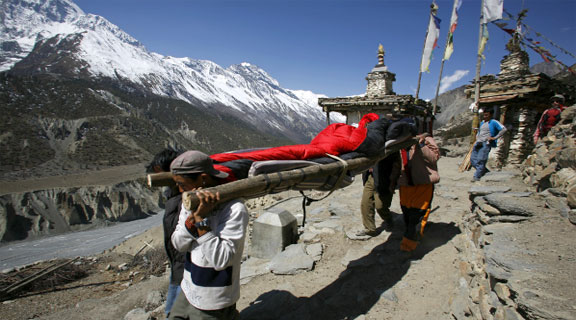
Altitude Sickness-Acute Mountain Sickness (AMS) is a medical consideration while trekking in the Himalayas. It rarely occurs lower than 2,800m and only minor symptoms occur below 3,000m. The sickness occurs when the body does not adjust well to less oxygen at higher altitudes.
Symptoms
The harmful effect of high altitude, which is generally caused by rapid exposure to low amounts of oxygen at high elevation is the common definition of altitude sickness. The mildest form of altitude sickness is known as acute mountain sickness (AMS). The first symptoms begin to show 12 to 24 hours after arriving at high altitudes. Different levels of altitude sickness have different symptoms. Symptoms of mild, short-term altitude sickness are dizziness, fatigue, loss of appetite, sleep problems, loss of energy, and shortness of breath.
• Vomiting
• Loss of appetite
• Sleeplessness
• Constant headache
• Dizziness, fatigue, lethargy, heavy legs
• Light swelling of hands and feet
• Breathlessness and irregular breathing
• Lesser urine
Prevention
Taking Diamox tablets during the trek acts as a prevention from altitude sickness. However, it will not cure the symptoms if the altitude starts hitting you. The only option after the sickness symptoms show up is to descend to a lower altitude. Himalayan Glacier trekking guides are well-trained and highly experienced to help you out of your sickness, but you should inform them the moment it starts hitting you. With decades of experience on the mountains, they know exactly if it is altitude sickness or something else that has been bugging you. Our guides are highly professional and wilderness first-aid (WFA) trained and act as medical assistants during emergencies.
When planning to trek to Everest base camp, there are few things to keep in mind if you wish to do so without any trouble relating to altitude sickness. First and foremost, you need to ascend slowly with proper rest and ample acclimatization. Drinking plenty of water and staying hydrated at all times will help prevent from the sickness as well. You need to eat enough and eat a balanced diet. We always recommend to stay away from alcoholic beverages, smoking cigarettes or chewing tobacco during the entire trek. Be headstrong and mentally prepared for the challenge by training your body to cope with uphill hikes by engaging in cardio-vascular or gym workouts at least 3 months before the trek.
NOTE: All Himalayan Glacier’s guides are trained and conscious to AMS. Our experienced staffs are expert in dealing with the effects of higher altitudes. They are equipped with necessary medical supplies and assist with basic first aid treatment. Overall, they are local people and hence familiar with precautionary measures.






